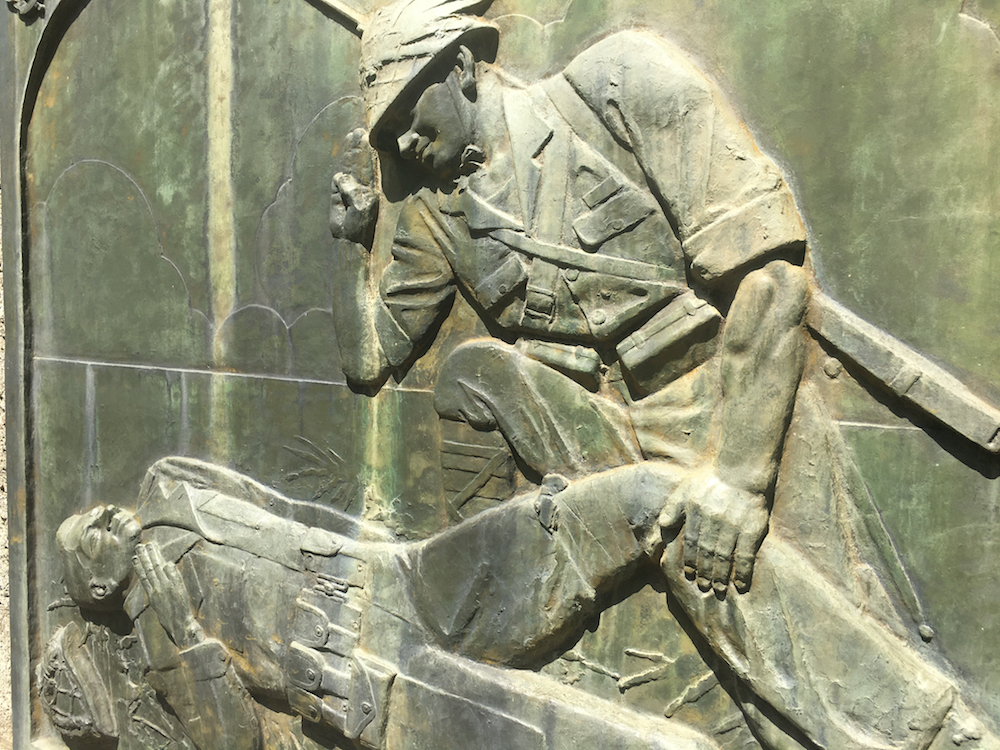Kodomo no Kuni Park, or “Children’s Country,” in the northwestern corner of Yokohama City has been a popular destination for families for more than half-a-century. Opened on May 5 (Children’s Day) in 1965, it was created using funds contributed by the Japanese public in honor of the Royal Marriage in 1959 of Prince Akihito, who later reigned as Emperor from 1989 to 2019, and Princess Michiko.
The park has slides, pools, a skating rink, camp and barbeque areas, a mini train, zoo, pony rides, cycling, boating and open spaces for many other activities. It wasn’t these opportunities, however, that brought me to the park recently. As a specialist on U.S.-Japan relations, I went to see a memorial that was built within the park in 1966 that commemorates a humanitarian act by a Japanese soldier toward a wounded American soldier during World War II.
The site of the battlefield is unknown, but it occurred on one of the countless Pacific Islands that the two countries fought over. Moreover, the soldiers’ names are also unknown.
The Story of the Yokohama Boy Scout Memorial
According to the story—a summary of which appears (only in Japanese) at the memorial site—the American soldier was wounded and in and out of consciousness when a Japanese soldier came upon him. The American awoke with a bayonet at his throat and believed he would be killed. As he passed out, he gave the Boy Scout salute of three fingers.
Seeing this, the Japanese soldier lowered his bayonet and instead took out his first aid kit and bandaged the enemy’s wound. He also scribbled a note in passable English and left it with the American.
When the American awoke, the Japanese soldier was gone. He saw the piece of paper and put it in his pocket. Shortly after that, he was rescued by friendly medical personnel and taken to a field hospital where he was saved. Later, he asked the staff for the note and read it.
“As I was about to stab you, you saluted me with the Boy Scout sign. I also was a Boy Scout. Boy Scouts are brothers. You are my brother. It is forbidden to kill anyone who no longer can fight. I applied a bandage to your wound. Good luck.”
The Story Takes Root

After returning to the United States, the soldier told his father what had happened. The grateful father in turn let the Boy Scouts of America know about it. Years later, in mid-April 1952, the story was relayed at an annual meeting of the BSA held near the soldier’s home and was introduced in the magazine Boys’ Life and other publications.
Later that spring, an executive of the BSA traveled to post-peace treaty Japan to help reorganize the Scout movement there. He told the wartime episode of the “brotherly love” shown by the Japanese soldier. This story immediately became national news in Japan, and a search was made for the Japanese man. Unfortunately, it is believed that he died later in the war.
“¥200,000 (in 1950s currency) in funds was raised”
Subsequently, Kurushima Hidesaburō, a former soldier who had been instrumental in involving Japan in the worldwide Boy Scout movement in the 1910s, became the chairman of the Boy Scouts of Japan in 1954 and began a fundraising drive to build a memorial in honor of the story of the two Boy Scout soldiers. A 10-yen movement was started, and eventually ¥200,000 (in 1950s currency) in funds was raised to make a relief featuring the interaction of the two men and designed by one of Japan’s leading sculptors at the time, an accompanying text plate and a statue of a saluting Boy Scout.
It was this memorial—called in Japanese “Mumei Senshi no Hi (Unknown Soldier Memorial)”—I wanted to see since first learning about it a year ago. It was definitely worth it, and might be for you too, especially if you have an interest in World War II, military history or the Scouting program.
To get there, transfer on to the Tokyu Kodomo no Kuni line at Nagatsuta Station on the JR Yokohama Line. Entry fees are reasonable and group rates apply.
More information can be found at: http://www.kodomonokuni.org/english/









